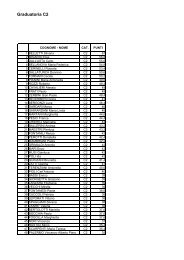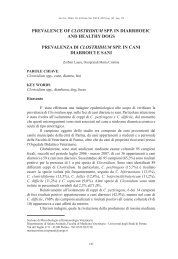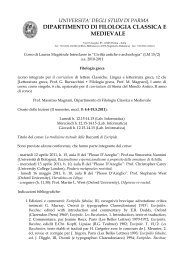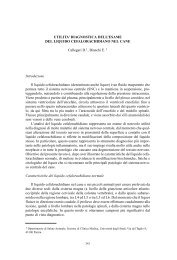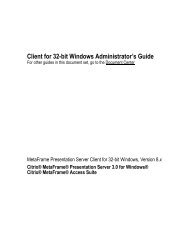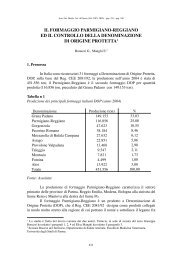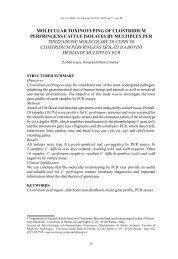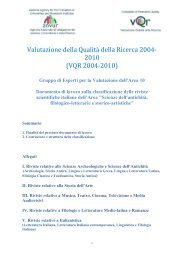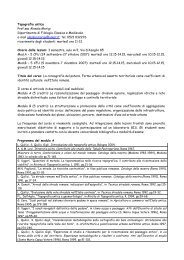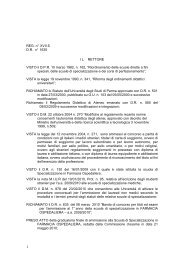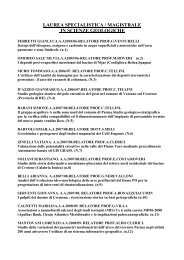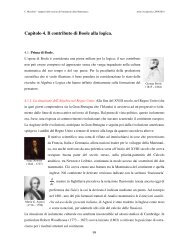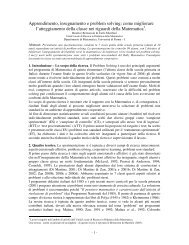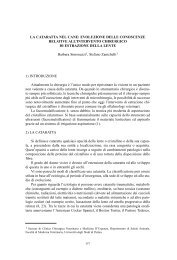porcine reproductive and respiratory syndrome
porcine reproductive and respiratory syndrome
porcine reproductive and respiratory syndrome
Create successful ePaper yourself
Turn your PDF publications into a flip-book with our unique Google optimized e-Paper software.
4 th International Symposium on Emerging <strong>and</strong> Re-emerging Pig Diseases – Rome June 29 th – July 2 nd , 2003<br />
routes. They can be susceptible to as few as 100 CCID50 of<br />
wild-type PRRSV given intramuscularly (7).<br />
Viremia - Wild-type PRRSV infection will usually produce a<br />
viremia (detected by virus isolation) for a duration of less than<br />
3 weeks with a majority of old swine having a viremia lasting<br />
less than 2 weeks.<br />
Transmission - Horizontal PRRSV transmission from old<br />
swine to age-matched animals after 6 weeks of infection is<br />
unlikely under experimental conditions (5,33,34). However,<br />
there is one experimental report of PRRSV being transmitted<br />
99 days-post-infection from sows to finishing age swine (67).<br />
Interestingly, under field conditions PRRSV may or may not<br />
easily transmit among sows within a naïve herd (even when<br />
they share a common water trough). Why there are these<br />
apparent differences in transmission rates between naïve<br />
herds is unknown. Field evidence suggests chronic PRRSV<br />
shedding occurs at a low frequency in old swine. This<br />
statement is based on collective field evidence where a sow<br />
herd regains normal production following a PRRS epidemic<br />
<strong>and</strong> eventually many of the sows become seronegative <strong>and</strong><br />
sentinels introduced into the sow herd do not become<br />
infected. The occurrence of PRRS-positive farms becoming<br />
PRRS-negative (22) suggests there are few sows in the herd<br />
that are chronically shedding PRRSV. These PRRS-positive<br />
herds that are clinically normal <strong>and</strong> eventually produce<br />
PRRS-negative pigs are referred to as PRRS-stable farms.<br />
As is the case all too frequently with PRRS, there are few, if<br />
any, absolute PRRS rules. Surely, there are times when<br />
sows do become infected with PRRSV <strong>and</strong> shed virus for<br />
extended periods of time. Perhaps these chronic shedders<br />
are what help keep some herds PRRS-unstable. To reinforce<br />
the comment "there are few, if any, absolute PRRS rules, one<br />
should keep in mind that subclinical PRRSV infections can<br />
occur in a herd.<br />
Vertical transmission is more likely to occur later in gestation<br />
than earlier <strong>and</strong> transplacental infection can occur within a<br />
week post-infection of the sow (14,29,30,35,36). PRRSV<br />
infection of the dam around the time of conception may have<br />
little direct impact on embryos, however, once they begin<br />
implantation, they may be more susceptible to PRRSV<br />
infection (49,50).<br />
Boars - Boars can shed PRRSV in semen for many weeks<br />
post-infection <strong>and</strong> in one case out to 92 days post-infection<br />
(15). Virus can be shed in semen intermittently, making<br />
negative semen tests from PRRSV-seropositive boars difficult<br />
to interpret. The quantity of virus shed in semen is not clear.<br />
This is an important issue if the amount of virus shed in<br />
semen is below the sensitivity of the test used to detect<br />
PRRSV in semen, yet this amount of virus is still infectious.<br />
The minimal infectious dose of PRRSV in semen for a sow is<br />
not known.<br />
Young Swine<br />
Susceptibility - Young swine also can be infected by the<br />
routes described above <strong>and</strong> pigs can be susceptible to as few<br />
as 20 CCID50 PRRSV given oronasally (66).<br />
Viremia - Wild-type PRRSV infection will usually produce a<br />
viremia (based on virus isolation) for a duration less than 7<br />
weeks, a majority will have a viremia lasting less than 5<br />
weeks.<br />
Transmission - Pigs infected with PRRSV have consistently<br />
shed virus up to 6 to 8 weeks-post-infection to age-matched<br />
pigs (57,62,65). One study reported virus transmission at<br />
about 22 weeks-post-infection to age-matched controls (1).<br />
30<br />
Congenitally infected pigs have shed virus to age-matched<br />
controls up to about 15 weeks-post-parturition (8).<br />
Persistence - In experimentally-infected pigs, PRRSV could<br />
be detected by virus isolation for 105 (27) <strong>and</strong> 150 days (2)<br />
post-infection <strong>and</strong> by PCR for up to 251 days post infection<br />
(63). Under field conditions it is assumed that PRRSV could<br />
persist in some pigs for even longer periods of time <strong>and</strong> these<br />
pigs could be a transmission risk. However, the significance<br />
of these animals as a transmission risk is unknown. In<br />
congenitally-infected pigs PRRSV nucleic acid was detected<br />
in the buffy coat for up to 230 days after parturition (8). In all<br />
of these studies that have detected virus or viral nucleic acid<br />
for extended periods of time post infection, the animals were<br />
always reported to be seropositive based on the methodology<br />
used in the respective laboratories.<br />
Immunotolerant - A PRRSV immunotolerant state may not<br />
exist in swine. Immunotolerance can be defined as a fetus<br />
that becomes infected with a pathogen early in gestation<br />
before the fetal immune system develops. The infection does<br />
not kill the fetus <strong>and</strong> as the fetal immune system develops the<br />
pathogen is recognized as normal fetal tissue. The fetus is<br />
born alive, is replicating the pathogen, sheds the pathogen for<br />
life, <strong>and</strong> has no detectable humoral immune response against<br />
the pathogen. Perhaps the best example of an<br />
immunotolerant state is the infection of the bovine fetus with<br />
bovine virus diarrhea virus (BVDV). The BVDV<br />
immunotolerant calf is a critical factor in the epidemiology of<br />
the disease since it is difficult to detect them <strong>and</strong> they shed<br />
virus to their penmates. In regards to PRRSV, a hypothetical<br />
immunotolerant pig could have tremendous impact in today's<br />
production systems where one pig could come into contact<br />
with thous<strong>and</strong>s of pigs.<br />
I have only tested fetuses as young as about 40 days of age<br />
with wild-type or attenuated PRRSV infections <strong>and</strong> have not<br />
been able to prove that PRRSV can induce an<br />
immunotolerant state in pigs (32). Wild-type PRRSV<br />
eventually kills the fetuses, so little or no chance for the<br />
development of an immunotolerant state. Fetuses can be<br />
infected with attenuated PRRSV <strong>and</strong> they appear normal;<br />
however, they do develop a detectable immune response <strong>and</strong><br />
the PRRSV-infected fetuses therefore are not<br />
immunotolerant. I think it would be a remote possibility that<br />
pigs could develop an immunotolerant state, i.e., a<br />
congenitally PRRSV-infected pig that does not develop a<br />
detectable humoral response to PRRSV <strong>and</strong> readily sheds<br />
PRRSV. Keep in mind that fetuses infected late in gestation<br />
can be born alive <strong>and</strong> may not have seroconverted by the<br />
time of parturition. However, if the pigs survive long enough,<br />
they do seroconvert.<br />
Indirect Transmission - Indirect transmission defined as<br />
PRRSV transmitted between swine that does not involve<br />
direct transmission.<br />
Possible modes of indirect transmission include aerosol,<br />
fomites, <strong>and</strong> vectors. Aerosol transmission is defined as the<br />
transfer of virus from one pig to another via movement of the<br />
virus in air. Field observations support this concept, perhaps<br />
over a considerable distance (28). Experimental<br />
observations support this concept over a distance of about 1<br />
meter (11,58). Fomites are objects that can be contaminated<br />
with a pathogen at one place <strong>and</strong> when moved to another site<br />
the pathogen is transferred, e.g., PRRSV-contaminated<br />
boots, gloves, needles, <strong>and</strong> semen-storage coolers<br />
(18,19,44). A vector would be a carrier of a pathogen from<br />
one pig or farm to another pig or farm. Mechanical vectors<br />
could be a PRRSV-contaminated creature, e.g., birds<br />
(carrying contaminated manure or feed on feet), blood-



